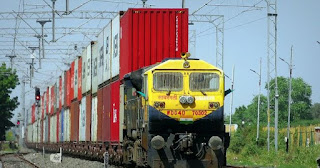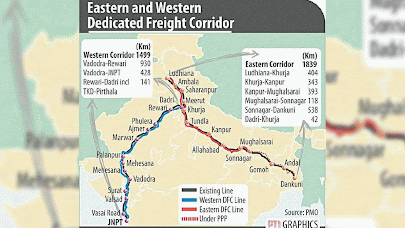DEDICATED FREIGHT CORRIDORS (DFC)
Dedicated freight corridors mean those railway routes that are being constructed for purpose of freight traffic. It consists of many freight-loading terminals but no passenger railway stations or terminals. The freight side is similarly very complex with daily over 30 lakh tons of freight being transported making it the 4th largest carrier of freight globally. In 2006, the government of India established a dedicated body to implement the project, called the Dedicated Freight Corridor Corporation Of India (DFCCI). The project involves the construction of six freight corridors traversing the entire country. The prime minister has inaugurated a 351 km section between Kharja and Bahurup in Uttar Pradesh for commercial operations of the Dedicated Freight Corridor (DFC). The Eastern Dedicated Corridor with a route of 1856 km consists of two distinct segments – an electrified double-track segment of 1409 km between Dankuni in West Bengal and Kharja in Uttar Pradesh and an electrified single-track segment of 1447 km between Udana(Dhandarkalan)-Kharja-Dadri in the state. Western DFC with a route of 1500 km starts from Dadri in Uttar Pradesh to Jawaharlal Nehru Port Trust in Mumbai, touching all major ports along the way. There is also a section under construction between Dadri and Kharja to connect the Eastern and Western arms. Prime Minister Narendra Modi inaugurated the 306 km New Rewari-New Madar section of the Western Dedicated Freight Corridor (WDFC) in January. The PM also flagged off the World’s first double-stack long haul 1.5 km long container train hauled by electric traction from New Ateli-New Kushagrah. The combined length of the Western and Eastern DFCs is approx. 2,843 km. The total cost of the project is estimated at $11.38 bn. The world bank is funding a majority of the EDFC. It is also being funded by the Japan International Cooperation Agency.

SIGNIFICANCE
The purpose of the project is to provide a safe and efficient freight transportation system. The DFC shall reform the transportation sector and will create more capacity on trunk routes of Indian Railways as good trains shall be able to run freely on DFC without any restriction imposed by the movement of passenger trains. The current speed of good trains in India is 25/26 km per hour. Once the DFC is ready, the speed will go up to 75-80 km per hour. DFCs are likely to encourage transit-oriented development and supremely impact the real estate market particularly commercial, warehousing, and logistics. DFC will have an impact on the industrial sector and employment sector. E-commerce companies like Amazon and Flipkart will be able to transfer freight through railways once the dedicated freight corridor project is complete. Apart from E-commerce, the freight corridor project will also open up doors for the automobile sector. Private containers will also be allowed to use the freight corridor but they have to pay track usage charges. It will be used to transport fertilizers, food grains, salt, coal, iron, steel, and cement. To develop the freight traffic infrastructure the government has designed an expansion drive in the form of DFC. The purpose is to create world-class rail infrastructure with advanced technology and knowledge to carry higher throughput per train and to improve overall transport efficiency. DFCCI will allow heavier, longer freight trains to ply faster on its network, effectively increasing the rail share of cargo movement and lowering the cost of logistics. It will help in running freight trains as per a definite timetable with a guaranteed delivery schedule. It will encourage higher productivity and lower the cost of transportation.

CHALLENGES
DFC faces so many challenges in the current years. To increase interoperability, we need to construct new routes in the form of corridors. Due to the high level of saturation on the Eastern and Western corridors, congestion and disruption in the timely delivery of raw materials along with the intermediate inputs in the supply chain can be witnessed. The project faced some difficulties usually faced in the execution of any railway project such as delay in land acquisition, resistance by the project-affected person (PAP), and environment/forest clearance. With the emphasis on the generation of power through renewable sources of energy, the future of coal demand appears to be uncertain now.
CONCLUSION
Once the DFC is Complete, the Indian economy will be bright. It is a major project that will take time to be implemented but will show results in long run and will help India in fulfilling its dream to become a major export hub.

